Contents
Market Overview
Macro Review
A week in which U.S. Treasury auctions became very relevant and a year on from the beginnings of the 2020 correction. The U.S. recorded its second weakest 5yr Treasury auction in a decade, which was followed by the worst 7yr auction on record with a 4.3bp tail (difference between auction yield and quoted market levels). This left the U.S. rate curve in a tailspin as nominal yields widened and steepened in aggressive fashion. The weakness fed into other asset classes, which meant the S&P and Nasdaq ended down -2.2% and -5.9% in six sessions, with the DXY crossing the 50dma. Powell’s remarks in front of the House Financial Services Committee were largely identical to Senate Banking Committee, but instead the market was left wanting more. The ECB may have toughened its language, as did the BoJ, while the RBA explicitly intervened with unscheduled yield curve control, capping yields in ACGB 3yr bonds. Instead, the focus will shift to Fedspeak into early March. Nevertheless, the frenzy in commodities ensued as copper finally breached $9,000/t (9yr highs), nickel was quoted above $20,000/t (7yr highs) and iron ore traded up to $175/t (10yr highs), just as Bitcoin rose to $58,000 before dramatically tumbling 20%. The Fed seems to have dominated most of the weekly events, although Deutsche Bank did raise its U.S. growth outlook to 7.5% and now has the highest growth estimate across Wall Street.
EM Credit Update
EM Corporates continued to significantly outperform EM Sovereigns. At the sovereign-level, Sri Lanka, El Salvador and Costa Rica outperformed this week, while Tunisia, Zambia and Armenia lagged. Corporates outperformed sovereigns by 10bp this week, after outperforming 20bp the previous week. Corporates firmly remain the defensive play and HY credit is still up 1.1% in 2021, while U.S. IG is down 3.7%. Primary market issuance remains subdued, but currently stands at $54bn in Sovereign and $117bn in Corporate Credit, in line with levels in 2020.
The Week Ahead
Aside from the Fed’s Beige Book and any script changes regarding Fedspeak, the EM calendar contains some notable events. Rate decisions from Malaysia (1.75%), Poland (0.1%), Sri Lanka (5.5%) and Ukraine (6.0%) stand out, followed by FX reserve data out of China. GDP releases from Brazil and Turkey will hit screens, along with inflation readings from Colombia, Indonesia, Peru, Philippines, Thailand, Turkey and South Korea. Beyond that, the focus on manufacturing PMIs from Poland and Czech Republic might get a mention, but given the dynamics over the past week, the overwhelming focus is likely to be on the Federal Reserve.
This week’s emerging markets highlights discussed below include the following: Following a turbulent week in Brazil’s markets, investor confidence hinges on fiscal reform outlook and Economy Minister Paolo Guedes remaining in his post; South Africa’s 2021 budget reflects positive cyclical momentum but fiscal risks persist; New U.S. sanctions on Russia are forthcoming in the near future, but will likely have very limited (if any) economic impact; and Global emerging market corporates in focus: Is that it? Assessing the ongoing impact of the COVID-19 pandemic.
Fixed Income
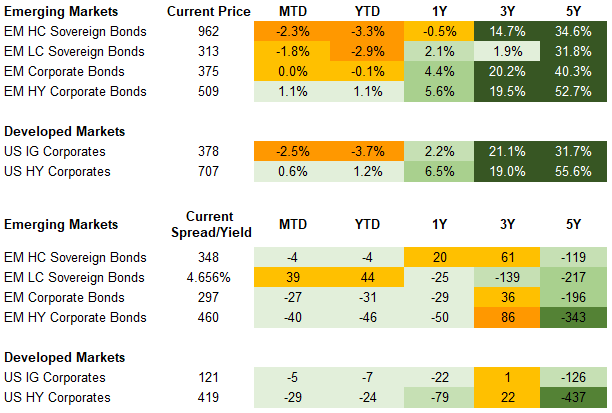
Equities
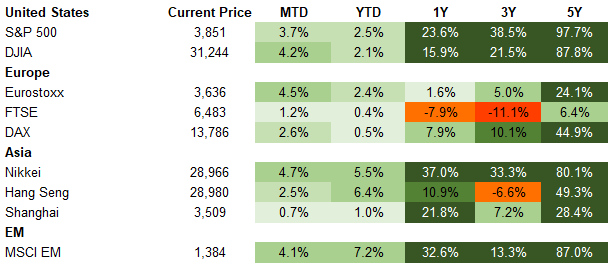
Commodities

Source for data tables: Bloomberg, JPMorgan, Gramercy. EM Fixed Income is represented by the following JPMorgan Indicies: EMBI Global, GBI-EM Global Diversified, CEMBI Broad Diversified and CEMBI Broad High Yield. DM Fixed Income is represented by the JPMorgan JULI Total Return Index and Domestic High Yield Index. Fixed Income, Equity and Commodity data is as of February 26, 2021 (Mid Afternoon).
Emerging Markets Weekly Highlights
Following a turbulent week in Brazil’s markets, investor confidence hinges on fiscal reform outlook and Economy Minister Paolo Guedes remaining in his post
Event: This week was an eventful one in Brazil from a market and macroeconomic perspective, starting with President Jair Bolsonaro’s unexpected decision to fire the CEO of Petrobras, Brazil’s state-owned oil giant. The choice unnerved markets on concerns about Economy Minister Paolo Guedes’ future and a potential stronger populist shift in economic policy by the Bolsonaro Administration. As the week progressed and in an effort to offset the credibility damage from Petrobras, the Administration introduced legislation that would pave the way for privatizing power generation company, Eletrobras, and Bolsonaro signed into law the formal autonomy of the Central Bank (BCB), a measure that has been under consideration since the early 1990s. Meanwhile, discussions in Congress over the modalities of additional fiscal stimulus and critically important counterbalancing fiscal savings measures are ongoing.
Gramercy Commentary: From an investor perspective, the key question resurfacing during this busy week in Brazilian markets was if Economy Minister Paolo Guedes would remain Brazil’s “economy tzar” in charge of setting the direction of economic policy under the Bolsonaro Administration. As of the moment, we think the answer to this important question is yes, as we believe Guedes is keen to cement his legacy as a market-friendly reformer for the remaining two years of the Bolsonaro Administration. Guedes’ orthodox economic policy approach and his liberal reform agenda are drivers of investor confidence and key anchors for the medium-term fiscal outlook in Brazil. What could change our assessment would be a potential failure by Congress to agree on and pass the additional economic relief measures (emergency stipend) for the population alongside counterbalancing fiscal savings measures championed by Guedes and his team. As such, this is the main downside risk for markets at the current juncture, but it carries a relatively low probability, in our view. Finding a political agreement on a medium-term fiscal adjustment path is of fundamental importance from a sovereign credit quality perspective, given Brazil’s already weak fiscal framework at the start of the pandemic, stretched even further by significant fiscal accommodation being delivered by the authorities to cushion the economy from the COVID-19 crisis. President Bolsonaro’s controversial decision to remove Petrobras’ highly respected CEO as a reaction to increases in retail fuel prices illustrates the very delicate social environment the Administration is facing. As we get closer to 2022, an election year, fiscal consolidation efforts will be getting progressively more challenging, which means that the Bolsonaro Administration has a relatively narrow window of opportunity this year to stop and potentially reverse the deterioration in fiscal metrics.
South Africa’s 2021 budget reflects positive cyclical momentum but fiscal risks persist
Event: On Wednesday, South African Finance Minister Tito Mboweni presented the upcoming fiscal year’s budget. The 2020/21 fiscal deficit was smaller than envisaged in the October MTBS (Medium Term Budget Statement) at 14.0% of GDP versus 15.7% of GDP while the deficit target for FY 2021/22 was narrowed to 9.3% of GDP from 10.1% of GDP. Debt to GDP is forecast to stabilize at just below 90% of GDP by FY 2024/25. Gross local issuance for 2021/22 is estimated at R380bn, which is R140bn lower than outlined in October, implying a roughly R2.5bn weekly decline. Foreign financing is expected to be $3bn for FY 2021/22.
Gramercy Commentary: The moderately more constructive fiscal path on the back of stronger revenues amid the economic recovery, lower issuance needs, positive real yields, relatively light investor positioning and the supportive external backdrop should continue to be beneficial for local currency bonds in the near-term offset in part by higher UST yields. However, fiscal risks remain sizeable and debt will likely remain on an upward trajectory. Structural growth challenges are unresolved, uncertainty regarding virus variants persists, and wage negotiations in the coming quarters pose downside risks particularly in the context of local elections later in the year.
New U.S. sanctions on Russia are forthcoming in the near future, but will likely have very limited (if any) economic impact
Event: Signals are becoming stronger that a “package” of punitive measures against Russia, including sanctions, will be unveiled by the Biden Administration in the coming weeks. The measures will be the White House’s response to the so-called “Solar Winds” cyber-attack allegedly orchestrated by Russian actors against U.S. public and private sector targets as well as the poisoning/imprisonment of Russian opposition activist Alexei Navalny.
Gramercy Commentary: As we have previously written, we do not expect broad and economically significant sanctions against Russia by the U.S. and/or EU, unless a material escalation in tensions between Moscow and the West takes place. There is clear reluctance in many European capitals to adopt an aggressive foreign policy stance against Russia, which would also likely limit the ability of the U.S. Administration to deploy tough measures, given Biden’s preference for a “multilateral” approach on using sanctions to induce change in geopolitical behaviors. European cautiousness will not prevent the U.S. Administration from imposing sanctions on its own amid strong pressure from Capitol Hill, but we expect any measures to be mild and targeted, thus falling well short of market-moving developments. In these still early days, the new Biden Administration is working on formulating the contours of its Russia policy and we think the Biden White House would be reluctant to start its relationship with the Kremlin completely on the wrong foot by imposing harsh sanctions. Furthermore, there are a number of critical global issues (climate change, nuclear arms control, and counter-terrorism) on which both governments share common interest to cooperate. As such, we remain of the view that Russian assets have excessive political risk premium embedded in them, especially the RUB that has lagged other major commodity-linked EMFX since the U.S. elections back in November.
Global emerging market corporates in focus: Is that it? Assessing the ongoing impact of the COVID-19 pandemic
Event: Spreads in much of the emerging markets corporate debt market continued to tighten until recently, as market participants became increasingly comfortable with support from governments, central banks and other authorities and with the much-discussed vaccine programs. In some cases, valuations did not appear to reflect the challenges some parts of our markets may still face. Management at one large Latin American bank described 2021 as a ‘transition year’ with normalization expected in 2022. There may be much truth in this.
Gramercy Commentary: It is likely that the pandemic may result in even greater differentiation within emerging markets. One reason for this may be the differently timed vaccine rollout schemes. Much focus has been given to the COVAX scheme but it is worth noting that Russia, China and India are already distributing vaccines to other countries classed as emerging markets under bilateral arrangements. In addition, the pandemic has not had the same impact on all jurisdictions. In particular, hospitalizations and deaths vary widely from one country to the next. This may also lead to increased differentiation. One positive is that the focus on environmental, social and governance factors has increased. This is already clear in the primary market where ESG-related issuance has accounted for over a quarter of new bonds placed so far this year. This seems likely to rise further. As authorities grapple with the impact of this pandemic, it seems inevitable that tough decisions on support may need to be made. Sadly, not all businesses can be saved. This not only impacts employment rates, but also asset quality at banks. Forbearance schemes, which have benefitted lenders and others, will eventually need to be wound down. Issuers’ standalone strength may become more important where government support schemes are curtailed or withdrawn. With rising U.S. rates now a mainstream theme, market access and funding costs may be impacted in parts of our markets. Less-strong equity and debt markets also have implications for banks’ securities portfolios.
Emerging Markets Technicals
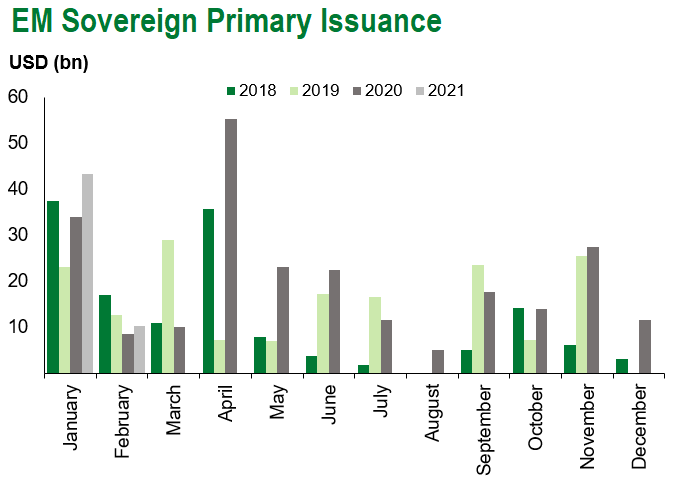
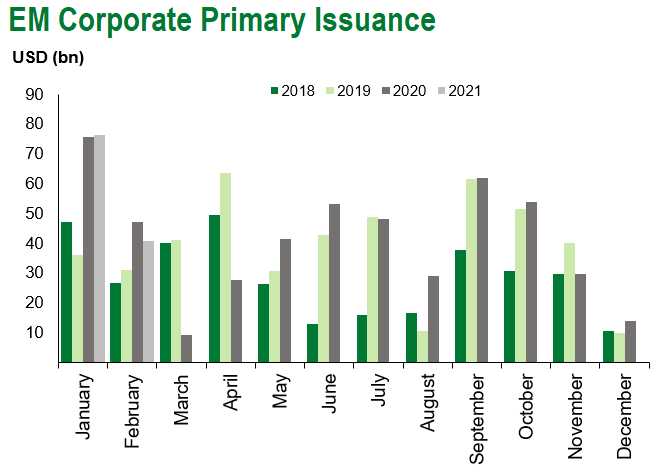
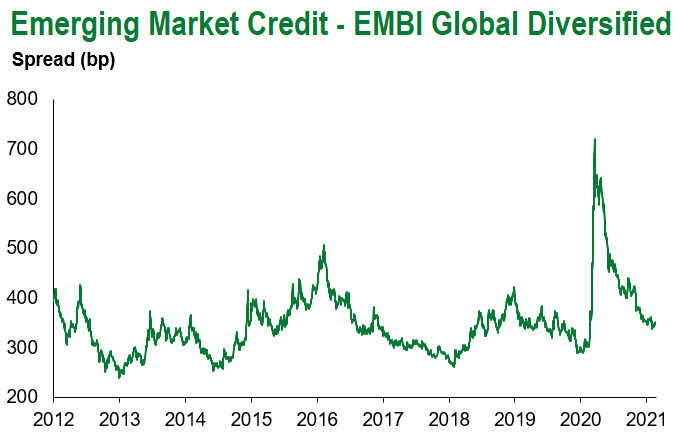
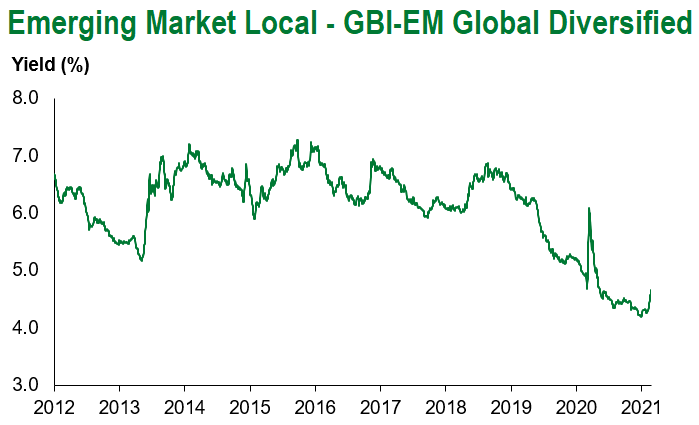
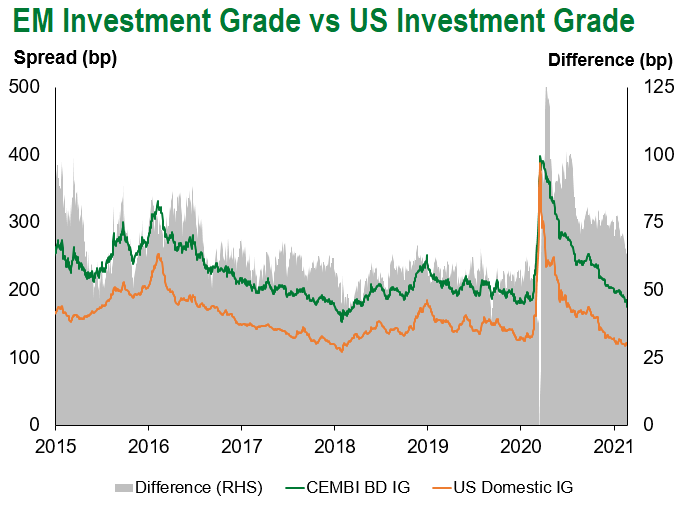
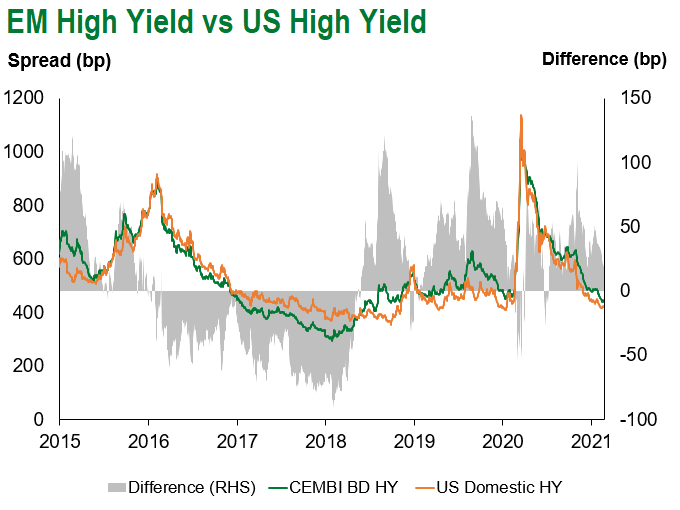
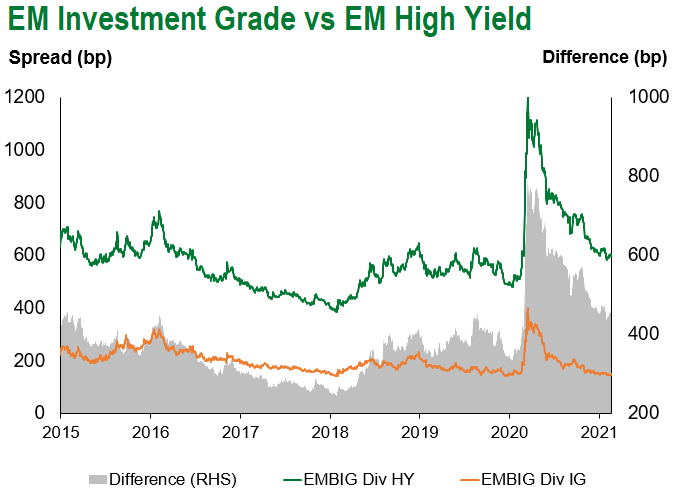
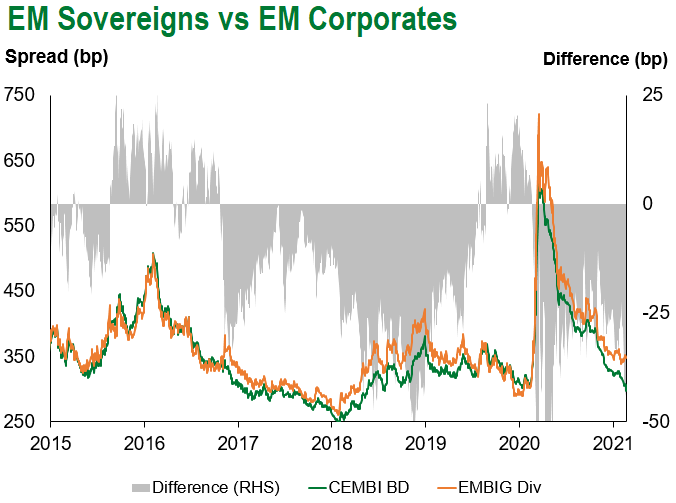
Emerging Markets Flows
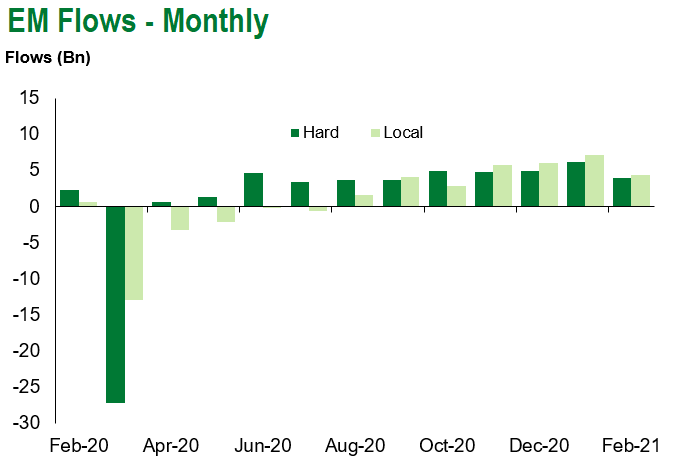
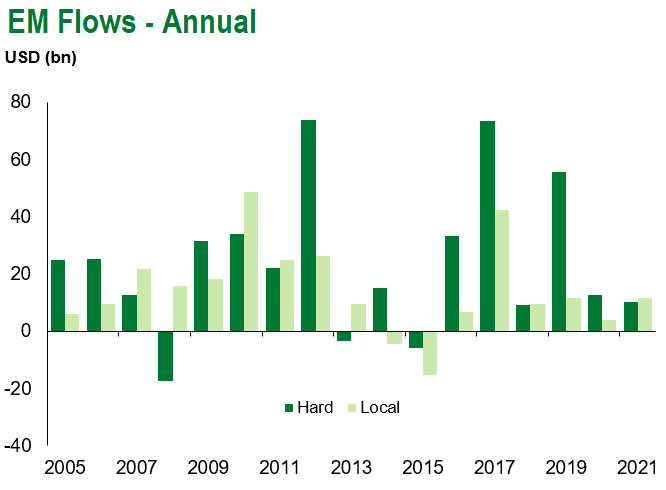
Source for graphs: Bloomberg, JPMorgan, Gramercy. As of February 26, 2021.
COVID Resources
Emerging Markets COVID-19 Case Summary
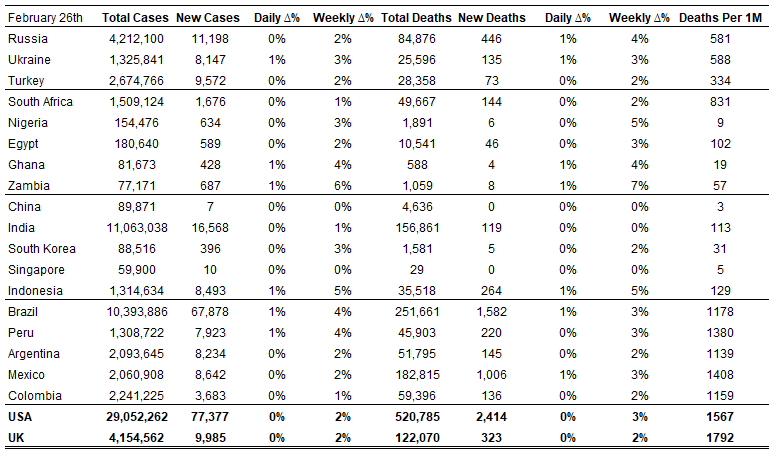
Source: Worldometer as of February 26, 2021.
Additional Crisis Resources:
Johns Hopkins COVID-19 Case Tracker
For questions, please contact:
Kathryn Exum, Senior Vice President, Sovereign Research Analyst, [email protected]
Petar Atanasov, Senior Vice President, Sovereign Research Analyst, [email protected]
Tolu Alamutu,CFA, Senior Vice President, Corporate Research Analyst, [email protected]
James Barry, Vice President, Corporate Research Analyst, [email protected]
This document is for informational purposes only. The information presented is not intended to be relied upon as a forecast, research or investment advice, and is not a recommendation, offer or solicitation to buy or sell any securities or to adopt any investment strategy. Gramercy may have current investment positions in the securities or sovereigns mentioned above. The information and opinions contained in this paper are as of the date of initial publication, derived from proprietary and nonproprietary sources deemed by Gramercy to be reliable, are not necessarily all-inclusive and are not guaranteed as to accuracy. This paper may contain “forward-looking” information that is not purely historical in nature. Such information may include, among other things, projections and forecasts. There is no guarantee that any forecasts made will come to pass. Reliance upon information in this paper is at the sole discretion of the reader. You should not rely on this presentation as the basis upon which to make an investment decision. Investment involves risk. There can be no assurance that investment objectives will be achieved. Investors must be prepared to bear the risk of a total loss of their investment. These risks are often heightened for investments in emerging/developing markets or smaller capital markets. International investing involves risks, including risks related to foreign currency, limited liquidity, less government regulation, and the possibility of substantial volatility due to adverse political, economic or other developments. The information provided herein is neither tax nor legal advice. Investors should speak to their tax professional for specific information regarding their tax situation.